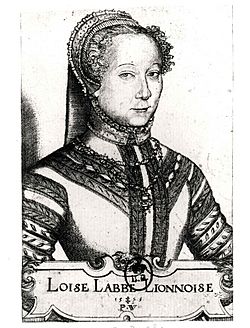Louise Labé facts for kids
Quick facts for kids
Louise Labé
|
|
|---|---|

Louise Labé; engraving by Pierre Woeiriot, 1555
|
|
| Born | 1522 Lyon, Lyonnais, Kingdom of France |
| Died | 25 April 1566 Parcieux-en-Dombes, Lyonnais, Kingdom of France |
| Language | French |
| Nationality | French |
Louise Charlin Perrin Labé, (c. 1524 – 25 April 1566), also identified as La Belle Cordière (The Beautiful Ropemaker), was a feminist French poet of the Renaissance born in Lyon, the daughter of wealthy ropemaker Pierre Charly and his second wife, Etiennette Roybet.
Biography
Louise Labé was born in Lyon, into a family of ropemakers, surgeons, and butchers. Her father, Pierre Charly, was a successful ropemaker, who started a business on rue de l'Arbre sec, at the base of Saint Sébastien Hill in Lyon. When his first wife died in 1515, he married Etiennette Roybet, and had five children: Barthélemy, Francois, Mathieu, Claudine, and Louise. It is presumed that Louise Labé was born at some point between her father's wedding in 1516 and her mother's death in 1523.
Records show that Labé's father, despite his humble beginnings, eventually achieved some social prestige. For example, in 1534, he was summoned before the Assemblée de Consuls of the city of Lyon to approve and participate in the founding of a relief agency for the poor.
At some point, perhaps in a convent school, Labé received an education in foreign languages (Greek, Latin, Italian, and Spanish) and music, specifically the lute.
As a young woman, she was acclaimed as an extraordinary horsewoman and archer. Her early biographers called her "la belle Amazone" and report that she dressed in male clothing and fought as a knight on horseback in the ranks of the Dauphin (afterwards Henry II) at the siege of Perpignan. She was also said to have participated in tournament jousts performed in Lyon in honor of Henry II's visit.
Between 1543 and 1545 she married Ennemond Perrin, also a Lyon ropemaker, a marriage dictated in her father's will, and which established the succession of the rope manufacturing business he was involved in. The business must have been prosperous, since the couple purchased a townhouse with a large garden in 1551, and, in 1557, a country estate at Parcieux-en-Dombes near Lyon.
Lyon was the cultural centre of France in the first half of the sixteenth century and Labé hosted a literary salon that included many of the renowned Lyonnais poets and humanists, including Maurice Scève, Clement Marot, Claude de Taillemont, Pontus de Tyard, and Pernette du Guillet.
The poet Olivier de Magny, passing through Lyon on his way to Rome, fell in love with Labé, and is the likely subject of her love sonnets. Magny's Odes contained a poem (A Sire Aymon) that mocked and belittled Labé's husband (who had died by 1557).
Perhaps inspired by the posthumous publication of Pernette du Guillet's collection of love poems in 1545, Labé began writing her own poetry. On March 13, 1555, Labé received from Henry II a privilège protecting her exclusive right to publish her works for a period of 5 years. Her Œuvres were printed in 1555, by the renowned Lyonnais printer Jean de Tournes. In addition to her own writings, the volume contained twenty-four poems in her honour, authored by her male contemporaries and entitled Escriz de divers poetes, a la louenge de Louize Labe Lionnoize ("Writings of diverse poets, in praise of Louise Labé of Lyons"). The authors of these praise poems (not all of whom can be reliably identified) include Maurice Scève, Pontus de Tyard, Claude de Taillemont, Clément Marot, Olivier de Magny, Jean-Antoine de Baïf, Mellin de Saint-Gelais, Antoine du Moulin, and Antoine Fumee. Her contemporaries compare her to Sappho and hail Labé as the Tenth Muse.
In 1564, the plague broke out in Lyon, taking the lives of some of Labé's friends. In 1565, suffering herself from bad health, she retired to the home of her companion Thomas Fortin, a banker from Florence, who witnessed her will (a document that is extant). She died there in 1566, and was buried on her country property close to Parcieux-en-Dombes, outside Lyon.
Works in English
- Complete poetry and prose : a bilingual edition, Chicago, Ill.; London: University of Chicago Press, 2006. ISBN: 9780226467153,
- Louise Labé's complete works, Troy, N.Y.: Whitston Pub. Co., 1986. ISBN: 9780878753192,
- Debate of folly and love, New York: P. Lang, 2000. ISBN: 9780820437521,
- Love sonnets, New York: New Directions, 1947.
- Love sonnets & elegies, New York: New York Review Books, 2014. ISBN: 9781590177310,
See also
 In Spanish: Louise Labé para niños
In Spanish: Louise Labé para niños
- Pernette Du Guillet
- Enzo Giudici

